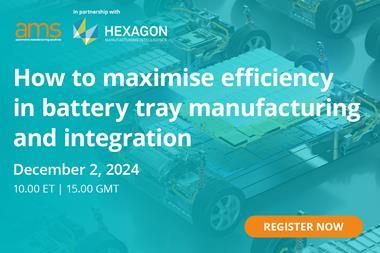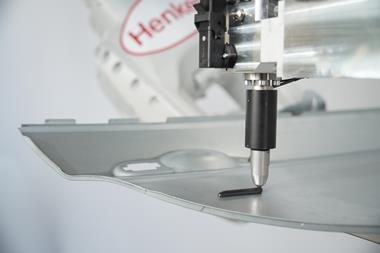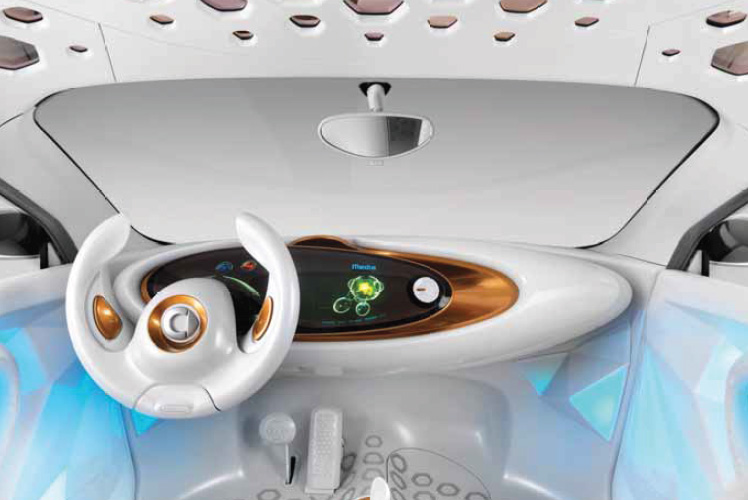
For many in the industry, both engineers and pundits, the greatest opportunity offered by plastics in automotive construction is metal replacement. However, it is not necessarily as simple as a straightforward swap; other aspects of vehicle design have to be addressed and, almost certainly, adjusted. Despite looking lighter and having cleaner lines, today’s vehicles are heavier than their predecessors – a Toyota Prius is 400kg heavier than a 1966 Ford Mustang, for example.
But there is little doubt that, piece for piece, a plastic replacement for a metal part will help to reduce weight, which helps to reduce carbon footprint and improve engine performance and economy. In the case of the electric vehicle sector, reduced weight can help to increase range. Although this segment is currently tiny – just 3,000 of the 30 million vehicles on the UK’s roads are electric – it is growing, both in share and importance, as evidenced by Nissan’s plans to commence production of the Leaf in Sunderland later in 2012.
Polypropylene (PP) penetration per vehicle has grown steadily, at an average annual rate of 3-5% over the last 25 years. PP has been used to replace both metals and other polymers in vehicle interiors, exteriors and underhood. Among the factors that will drive future growth are innovative developments; ease of processing; and quality and value requirements. The average use of PP per car in Europe is currently 68kg of 150kg total thermoplastics (45%) and the strongest growth area is in semi-structural parts, where integration of complex items can reduce overall system weight and cost by up to 30%. The leading external PP application is bumper fascias, and highly integrated PP front-end modules can combine 25 components into one injection-moulded component. While the cost of investment in new assembly layouts and technologies may have held the further adoption of plastic back, opportunities for further conversion from steel and alloy, for example in body panels, will increase as new platform types – such as electric vehicles – emerge.
Looks good, feels good
Developments in PP and thermoplastic (TPO) technologies have led to extensive use in interiors. As stiffness, impact and 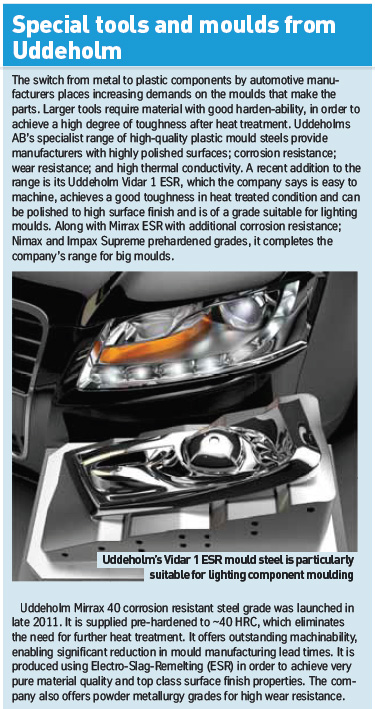 flow improve, higher levels of integration and thinner wall sections become possible. ‘Plastic’ now looks better than was the case a couple of decades ago and PP components with matt finishes, softness to the touch, low levels of squeak and rattle and low emissions and odour mean that even premium vehicles are extensively finished in the material. Long-fibre PP is increasingly used in semi-structural interior applications, such as door modules and instrument panel carriers. Instrument panels themselves, along with A and B pillar trims, carry airbags and other protection systems and are increasingly safety-critical. Underhood, PP can be found where heat is non-critical. Engineered PP compounds are replacing metals and a range of thermoplastic polymers in fan-shrouds, HVAC components, pressure vessels and inlet manifolds.
flow improve, higher levels of integration and thinner wall sections become possible. ‘Plastic’ now looks better than was the case a couple of decades ago and PP components with matt finishes, softness to the touch, low levels of squeak and rattle and low emissions and odour mean that even premium vehicles are extensively finished in the material. Long-fibre PP is increasingly used in semi-structural interior applications, such as door modules and instrument panel carriers. Instrument panels themselves, along with A and B pillar trims, carry airbags and other protection systems and are increasingly safety-critical. Underhood, PP can be found where heat is non-critical. Engineered PP compounds are replacing metals and a range of thermoplastic polymers in fan-shrouds, HVAC components, pressure vessels and inlet manifolds.
PP is economical to produce in high volumes. The base polymer lends itself easily to modification and compounding, enabling it to provide a range of properties. Its low weight and comparatively low inherent carbon footprint allows the creation of highly-integrated parts that reduce vehicle emissions and the carbon footprint of a given application or module. It very recyclable and ‘closed loop’ systems are becoming more widespread. It can be reinforced with long and short glass fibres, which can be replaced with sustainable natural fibres. It can even be produced from biofeedstock. Plastics generally bring more than just piece-for-piece replacement and lighter weight. The fact that they can be moulded into complex geometrical shapes can help to reduce the number of steps involved in production. Advances in engineered plastics for underhood applications means that they can be used even in the high-temperature environment of engine manifolds; BMW introduced the first polyamide manifold in the 1990s and only a handful of new cars today use alloy in this application. Bayer MaterialScience recently announced that the new Mercedes SLK convertible will have a roof system with a 0.8 sq m element made of its Bayblend T85 XF thermoplastic. This is worthy of note because it is large and horizontal, indicating that previous challenges of warpage, stress resistance energy absorption have been overcome and represents another milestone in the advance of engineering plastics.
Lightweighting limitations
This all sounds very promising and indicates that plastics are continuing their steady advance in auto construction. However, a recent report1 into the use of plastics in automotive – particularly polyamide – found that both their proportion of total vehicle weight and their total absolute use had shown a decline in the period 2004-2010. The question then is: if plastics are so promising and offer so many opportunities, how and why should this be the case? The average weight of vehicles examined has declined only very slightly, by 20kg over the five years. While there is a weight reduction in B segment cars, those in C and D show a slight gain overall. While the overall market share of B segment cars rose, and vehicle engine sizes are reducing, which should lead to lighter weight, this trend is challenged by the increasing number of electric and electronic features aimed at improving safety, comfort and ‘driving experience’. Excluding seating systems, the use (by weight) of polyamide (PA) fell by an average of 30% per vehicle studied; polypropylene (PP) declined even more, by just over 44%. The trend was found to be stronger in Asia than in Europe; in fact, PP use actually increased slightly in 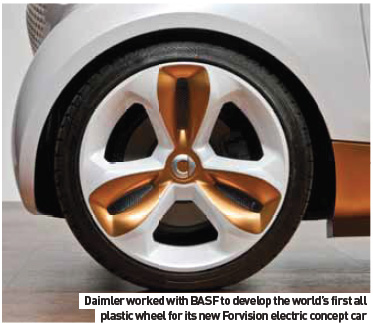 European cars, which tends to emphasise the reduction in vehicles in Asia. The chief reasons for these declines appear to be found under the bonnet. Reduced engine sizes, more turbocharging and smaller engine manifolds have enabled newer cars to save about 15kg overall – three-quarters of the total weight loss observed in the period 2004-2010. While the proportion, by weight, of PA use in the engine compartment has remained relatively steady across the market as a whole, it has declined sharply in the case of boosted engines. As turbocharged units can be smaller for the same power output as unboosted equivalents, and as the market penetration of diesel power has grown, boosted engines have become pretty much mainstream. But as engines get smaller, so do manifolds – average weight in 2010 was only half what it was in 2004 – and thus the use of the material falls. Optimisation of cooling systems also appears to be leading to a decline in usage of PA, in absolute terms, and this is the case with both boosted and normally-aspirated engines, although the trend is stronger in the latter.
European cars, which tends to emphasise the reduction in vehicles in Asia. The chief reasons for these declines appear to be found under the bonnet. Reduced engine sizes, more turbocharging and smaller engine manifolds have enabled newer cars to save about 15kg overall – three-quarters of the total weight loss observed in the period 2004-2010. While the proportion, by weight, of PA use in the engine compartment has remained relatively steady across the market as a whole, it has declined sharply in the case of boosted engines. As turbocharged units can be smaller for the same power output as unboosted equivalents, and as the market penetration of diesel power has grown, boosted engines have become pretty much mainstream. But as engines get smaller, so do manifolds – average weight in 2010 was only half what it was in 2004 – and thus the use of the material falls. Optimisation of cooling systems also appears to be leading to a decline in usage of PA, in absolute terms, and this is the case with both boosted and normally-aspirated engines, although the trend is stronger in the latter.
Non-engine compartment applications of PA also show a reducing trend but this figure fluctuates – in part, reflecting the cycle of new car introductions. If a manufacturer like BMW, for example, revamps its larger vehicles, then the trend can seem to be on an upward curve but this appears to be more than offset when OEMs with more cars in the A, B or C segments introduce new models. that change is a constant in vehicle design. Just as these engineered plastic grades have replaced metals, so are they themselves replaced when a new material comes along.
Out with the old, in with the new
Mazda has just announced that it and the Japan Polypropylene Corporation have jointly developed a resin material that maintains the same rigidity as conventional materials, while achieving significant reduction in weight, raw material use and production time. It will first be seen on bumpers in the new Mazda CX-5 SUV, which is due to go on sale in spring 2012. The resin incorporates two components found in polypropylene and rubber, blended together and distributed in a double-layer structure in line with the required function for the surface and the inside of the base bumper material. Mazda says that the surface has excellent paint film adhesion and the inner section retains high rigidity and impact absorption. The new material enables the manufacture of parts that are thinner than those made using conventional resin, which results in less being required for part production. A weight reduction of approximately 20% in front and rear bumpers has been achieved. The reduced thickness also leads to a shorter cooling period and optimisation of fluidity, realised by using computer-aided engineering (CAE), has helped to cut total moulding time by half, from a minute to just 30 seconds.
maintains the same rigidity as conventional materials, while achieving significant reduction in weight, raw material use and production time. It will first be seen on bumpers in the new Mazda CX-5 SUV, which is due to go on sale in spring 2012. The resin incorporates two components found in polypropylene and rubber, blended together and distributed in a double-layer structure in line with the required function for the surface and the inside of the base bumper material. Mazda says that the surface has excellent paint film adhesion and the inner section retains high rigidity and impact absorption. The new material enables the manufacture of parts that are thinner than those made using conventional resin, which results in less being required for part production. A weight reduction of approximately 20% in front and rear bumpers has been achieved. The reduced thickness also leads to a shorter cooling period and optimisation of fluidity, realised by using computer-aided engineering (CAE), has helped to cut total moulding time by half, from a minute to just 30 seconds.
Applications using plastic in the interior range from large to small, from dashboards to gear levers and cupholders. Whatever use it is being put to, the material has to meet particular demands and requirements – and this is where plastics very much come into their own. Polyamides can be engineered for specific applications and characteristics, with more or less, and longer or shorter fibre reinforcement. Fischer Automotive uses Grivory GVX polyamide with 50% glass fibre content in the arms and a facing support of the cup holder used in Porsche Panamera models. The same material, but with 65% glass fibre content, is used by Leopold Kostal Company in place of die-cast zinc to produce shift levers for automatic gearboxes. Not only does it have to feel right and look at least as good as the material it is replacing, the lever has to absorb shifting forces of up to 250 Nm in four directions. In the event of a crash, it must break in a defined way and in an uncritical area at a maximum of 380 N, so as to prevent injury. It must also be very stiff and has to have a high-quality surface finish. Leopold Kostal and EMS-Grivory collaborated on the gear lever design, which was optimised using various Moldflow and finite element analyses.
Materials and moulds
The technologies involved with plastics production have been the focus of the drive for improvement as well. DuPont has announced a new IMHP (In-Mould Hold Pressure) technology that is claimed to reduce cycle time of semicrystalline thermoplastics, which traditionally require longer holding times because of their high rate of volume shrinkage during cooling. The company says that this process can reduce the cycle time by the shorter of either the entire dosing or hold pressure time, by up to 30%. Krauss-Maffei has supplied German company Muerdter, a mould maker and moulder, with 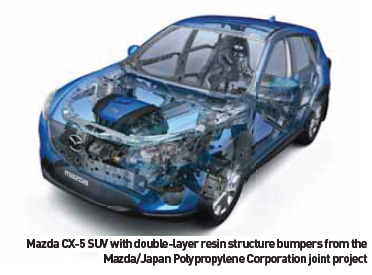 the world’s largest MuCell process-enabled injection moulding machine. During the MuCell process, precisely metered quantities of nitrogen or carbon dioxide are introduced in the plasticising unit of an injection moulding machine, which creates a microcellular material structure in the end product. These are claimed to deliver benefits including improved part quality and reduced production costs. Even techniques like ‘lost-core’ technology, which incorporates a core with a low melting temperature such as a bismuth-tin alloy, are making a comeback in the search for greater production efficiency and integration. Some of the major advances are in material developments, which are driven by conventional vehicles’ need for lighter weight, increased recyclability and reduced carbon footprint, by legislation and by the emergence of electric vehicles. Emissions of VOCs (volatile organic compounds) have been the subject of a great deal of attention and European legislation has required dramatic reductions. This has impacted upon otherwise-useful materials but DuPont has developed a new addition to its range of impact-modified POMs (polyoxymethylenes). Delrin 300TE has a reduced formaldehyde content and low rate of emission release, making it suitable for car interiors. Its melt flow index (MFI190/2,16) of 6 g/10min places it between Delrin 100T (MFI = 2) and Delrin 500T (MFI = 12). Delrin 300TE achieves a notched impact strength at 23 °C of 18 kJ/m. “Thin-walled parts with long flow paths - for instance the struts used in headrests - are amongst the principal areas for developments in Delrin 300TE,” said Hans-Hermann Kirner, material development manager for automotive interiors at DuPont.
the world’s largest MuCell process-enabled injection moulding machine. During the MuCell process, precisely metered quantities of nitrogen or carbon dioxide are introduced in the plasticising unit of an injection moulding machine, which creates a microcellular material structure in the end product. These are claimed to deliver benefits including improved part quality and reduced production costs. Even techniques like ‘lost-core’ technology, which incorporates a core with a low melting temperature such as a bismuth-tin alloy, are making a comeback in the search for greater production efficiency and integration. Some of the major advances are in material developments, which are driven by conventional vehicles’ need for lighter weight, increased recyclability and reduced carbon footprint, by legislation and by the emergence of electric vehicles. Emissions of VOCs (volatile organic compounds) have been the subject of a great deal of attention and European legislation has required dramatic reductions. This has impacted upon otherwise-useful materials but DuPont has developed a new addition to its range of impact-modified POMs (polyoxymethylenes). Delrin 300TE has a reduced formaldehyde content and low rate of emission release, making it suitable for car interiors. Its melt flow index (MFI190/2,16) of 6 g/10min places it between Delrin 100T (MFI = 2) and Delrin 500T (MFI = 12). Delrin 300TE achieves a notched impact strength at 23 °C of 18 kJ/m. “Thin-walled parts with long flow paths - for instance the struts used in headrests - are amongst the principal areas for developments in Delrin 300TE,” said Hans-Hermann Kirner, material development manager for automotive interiors at DuPont.
Dow Chemicals has launched Engage XLT, a new grade of polyolefin elastomer for TPOs (thermoplastic olefins) used for automotive interior and exterior components. Improved impact efficiency enables lower elastomer loading in the TPO while still delivering the required impact performance. Lower elastomer loading results in higher TPO stiffness and melt flow, and allows thin-walling for reduced final part weight. Dow’s computer simulations have shown a reduction of up to 10 percent in the total weight of a part made with Engage XLT, and the reduced wall thickness improves moulding cycle times.
“The ability of Engage XLT to facilitate the production of lighter, larger parts with a faster mould time will allow compounders and manufacturers to cost-effectively produce fuel-efficient vehicles without compromising quality,” said Dave Mitchell, marketing manager at Dow Elastomers.
EV efficiency – wheels and wires
BASF has been working with Daimler on the development of Forvision, an electric concept car. A particular breakthrough was the first ever all-plastic wheel, which is made from BASF’s high performance Ultramid Structure material, which is a nylon 6 reinforced with 50% long glass fibre. BASF says the material is as stable as metal and reduces weight by up to 30%. Lightweighting developments such as this have helped the Forvision achieve a range of105 miles, up from the 86 miles achieved by the Smart’s third-generation electric car, which will be available next year.
The use of plastics in electric cars requires electronicfriendly polymers. DuPont’s response has been the development of Zytel HTN PPA EF resins, which can be used for metal replacement in electric vehicle motors or batteries, according to Rob Coates, DuPont automotive development consultant Rob Coates. DuPont also supplies Vamac AEM, a halogen-free flame retardant (HFFR) elastomer, for thin wall insulation in battery cables. It enables weight reduction and efficient operation at the high temperatures generated by high voltage electric currents.
“We have European legislation coming in that governs the average C02 emissions of an OEM to around 130g of C02 per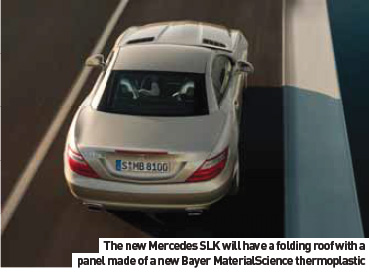 KM per vehicle,” Coates observed. “That’s what a lot of the big manufacturers are moving towards.” Lightweighting is part of the answer but so is improved engine performance and techniques like turbocharging, which can help to maintain power while reducing engine size.
KM per vehicle,” Coates observed. “That’s what a lot of the big manufacturers are moving towards.” Lightweighting is part of the answer but so is improved engine performance and techniques like turbocharging, which can help to maintain power while reducing engine size.
“A family vehicle with a 2.0-litre engine might in the future have a 1.6-, 1.3- or even a 1.0-litre, engine,” says Coates. Due to the ease of moulding complex shapes, plastics are ideal materials for integrating several parts into one leading to weight savings. “But a lot of these things put the temperature, and the thermal load, up.” DuPont’s Zytel PLUS range of polyamide-based resins have demonstrated improved heat aging performance at over 200 °C for 3,000 to 4,000 hours over vehicle life. Various structural structural polymers ‘green’ characteristics are also available.
“Sorona EP is a polyester material that can be used for fibre production for carpets and fabrics, or it can be injection moulded,” Coates says. “It can also be glass reinforced for use in more structural components.” Sorona EP has surface finish that doesn’t require painting and was used in the heating and ventilation system of the Toyota Prius. DuPont also produces a renewably sourced (RS) version of its Hytrel TPC-ET family, a thermoplastic elastomer, as well as RS versions of its Zytel PA range, which are used in more structural components. While ‘green’ materials are often more expensive than standard engineering plastics, this may change as their uptake becomes more widespread and the price of oil continues to rise.
The past 20 years have seen significant advances in the composition and use of plastics, as well as their effective integration. The challenge of new platforms, as well as the ongoing requirement to reduce weight and get ‘more bang for the buck’ is expected to see further advances over the next decade.






























